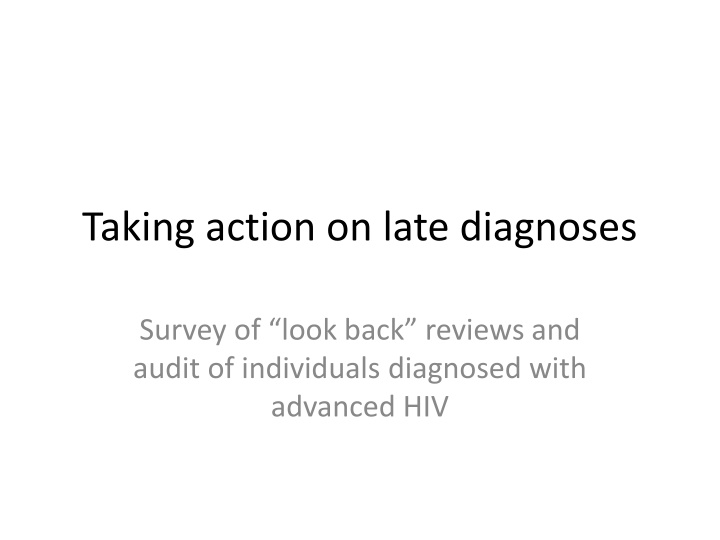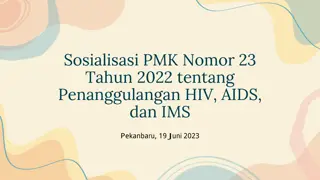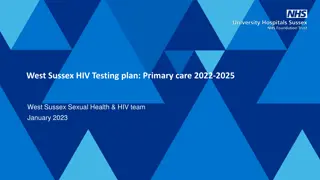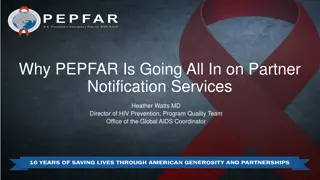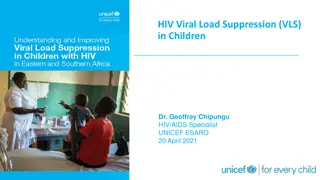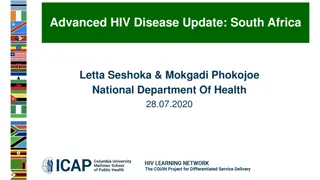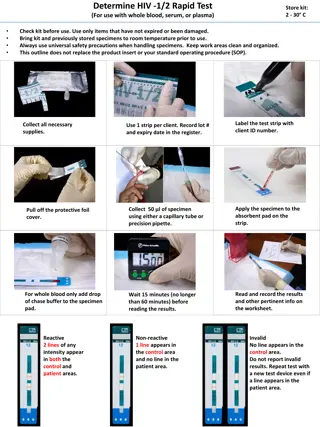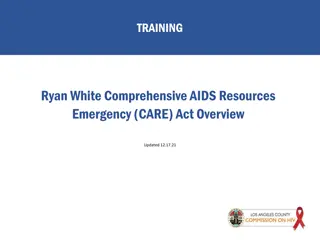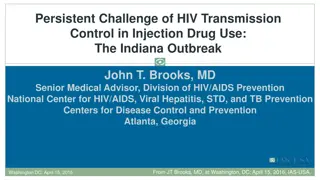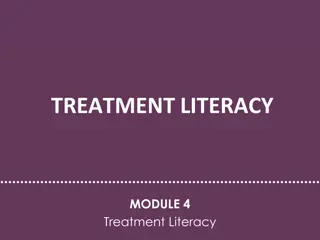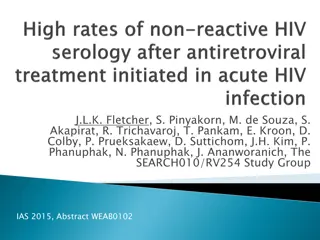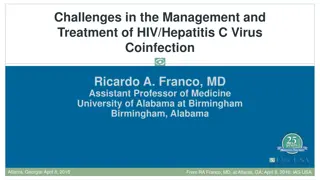Addressing Late Diagnoses of Advanced HIV
Late diagnosis of HIV remains a significant issue, with many individuals presenting at an advanced stage of the disease. This study explores the processes and impact of look back reviews and audits in identifying missed opportunities for earlier diagnosis and intervention. The findings highlight the importance of conducting systematic reviews to improve timely detection and care for individuals with advanced HIV.
Download Presentation

Please find below an Image/Link to download the presentation.
The content on the website is provided AS IS for your information and personal use only. It may not be sold, licensed, or shared on other websites without obtaining consent from the author.If you encounter any issues during the download, it is possible that the publisher has removed the file from their server.
You are allowed to download the files provided on this website for personal or commercial use, subject to the condition that they are used lawfully. All files are the property of their respective owners.
The content on the website is provided AS IS for your information and personal use only. It may not be sold, licensed, or shared on other websites without obtaining consent from the author.
E N D
Presentation Transcript
Taking action on late diagnoses Survey of look back reviews and audit of individuals diagnosed with advanced HIV
Background Late HIV diagnosis remains a serious problem in 2014 40% of newly diagnosed adults had CD4 <350 cells/mm3 BHIVA standards (2013) state: All HIV services should undertake a review of all patients presenting to care with advanced immunosuppression (CD4 count <200 cells/mm3or AIDS diagnosis), with look back of previous engagement with health care services. A summary should be provided to commissioners to aid greater understanding for interventions which can be implemented to reduce late diagnosis annually
Background, continued In 2015 BHIVA published Recording and investigation of late HIV diagnoses: good practice position statement: Advice for HIV clinical services on ways of conducting look back reviews of late diagnoses To identify and learn from possible missed earlier opportunities for testing
Methods Survey to assess how many HIV services have conducted look back reviews, methods used, and impact Audit of up to 10 individuals per site diagnosed with advanced HIV (CD4 <200 cells/mm3) during 2015 and 2016 up to audit date
Participation 129 sites completed the survey 135 sites submitted audit data for 773 late diagnosed individuals A further 4 sites reported that they had no eligible patients
Conduct of look back reviews 58 (45%) sites had taken part in a planned, systematic exercise to review previous health care use by late diagnosed individuals: 53 review within own service/organisation* 2 as part of multi-organisation or regional review 2 both* 1 not answered *The rest of the survey data is based on the 55 reviews within the respondent s own service/organisation.
Inclusion in reviews 20 (36%) sites: all new diagnoses, without selection 25 (45%): low CD4 at diagnosis 6 (11%): low CD4 or symptomatic disease 4 (7%): symptomatic disease only
Type of review *Of 21 sites reporting one-off reviews, 14 had done one in 2014-16, 6 earlier and 1 did not state when.
Costs associated with late diagnoses 8 (14.5%) of reviews had involved some attempt at quantifying avoidable financial costs resulting from missed/late diagnosis of HIV Methods included applying standard reference costs to types of attendance/admission
Improving HIV testing practice Areas for improvement were identified in: Secondary care: by 80% of sites conducting reviews Primary care: by 76% Community test sites/other non-clinical settings: by 29% Only 8 of 55 sites conducting reviews reported no areas for improvement
Secondary care areas for improvement mentioned by respondents for more than 10% of reviews: Emergency/A&E Medical admissions Haematology Gastroenterology Respiratory medicine Internal medicine Dermatology
Data sources and areas for improvement in secondary care Number (%) finding areas for improvement in secondary care Review used sources including: Number of sites Record within trust/organisation AND information requested from external secondary service(s) 12 12 (100) Record within trust/organisation 36 30 (83) Neither (eg patient-reported histories only) 7 2 (29)
Data sources and areas for improvement in primary care Number (%) finding areas for improvement in primary care 17 (74) Number of sites 23 Review used sources including: Information requested from GPs Information not requested from GPs (eg patient-reported histories and/or trust/ organisation records only) 32 25 (78)
Value of data sources: Including secondary care data in reviews appears to add value in identifying areas for improvement in secondary care Requesting information from GPs does not appear to add value in identifying areas for improvement in primary care NHS data spine/automated systems could not be assessed as few sites used these, and did so together with other data sources
Action based on review findings Key: Blue bars/bottom axis: number of sites taking action; Red dots/top axis: of sites taking action, percentage rating it 4 or 5 out of 5 for effectiveness.
Audit of individuals diagnosed with advanced HIV 773 adults with CD4 <200 cells/mm3 at/shortly after diagnosis in 2015-6
Demography Number 557 213 2 1 288 430 16 6 33 Percent 72.1 27.6 0.3 0.1 37.3 55.6 2.1 0.8 4.3 Male Female Trans Not stated MSM Heterosexual IDU Other Not known/not stated
Migration to UK after living abroad Number Percent Non-migrant 378 48.9 Arrived >2 years before diagnosis 251 32.5 Arrived 1-2 years before diagnosis Arrived 6 months-1 year before diagnosis 28 19 3.6 2.5 Arrived <6 months before diagnosis 38 4.9 Migrant, arrival date not known/reported Not known/reported whether migrant 35 4.5 24 3.1
Place of diagnosis Number Percent In-patient 240 31.0 GUM/HIV/sexual health clinic 182 23.5 General practice 117 15.1 Out-patients (not GUM/HIV/sexual health) 117 15.1 A&E or admissions unit 34 4.4 Antenatal clinic 21 2.7 Home test/home sampling 12 1.6 Community HIV test service 8 1.0 Other 36 4.7 Not stated 6 0.8 676 (87.5%) were registered with a GP at time of diagnosis.
Information in record re health at diagnosis and during previous 2 years *Or, confirmation that the individual was not receiving prescribed medication.
Information recorded about service use in 2 years preceding diagnosis
Earlier missed opportunities for diagnosis 257 (33.2%): documented in record 100 (12.9%): not documented, but identified in retrospect at audit 46.2% could have been diagnosed sooner Most missed opportunities were recognised and documented before audit
Circumstances of documented missed opportunities 182 (70.8%) clinician did not offer test when it would have been appropriate 20 (7.8%) patient declined offer of test 12 (4.7%) both of above on different occasions 43 (16.7%) unclear
Action on documented missed opportunities 128 (49.8%) informal discussion 45 (17.5%) presented as case at grand rounds or similar 14 (5.4%) serious untoward incident procedure and/or root cause analysis 43 (16.7%) other action 87 (33.8%) no reported action.
Learning from 257 documented missed opportunities 34 (13.2%) respondent was aware of change in HIV testing practice arising wholly or partly from learning based on this patient s case 144 (56.0%) no such change 75 (28.8%) not sure 5 (1.9%) not answered
Reflections Gastroenterologists now routinely consider HIV test with IBD/chronic diarrhoea Difficult to assess outcomes in other settings Problems lack of HV awareness. Success 98% uptake in ID Provided excellent results for routine HIV testing in TB patients and hepatology (and some gastroenterology) clinics More offer of HIV test on acute medical admissions Subsequent patient admitted with a similar presentation was offered an HIV test A drop in the ocean.. Need to sustain these activities
Summary Most services had not done an organised look back review of late diagnoses Most such reviews relied on patient- reported history plus records held within the hospital/trust/organisation Despite this limited data, nearly all reviews found areas for improvement in HIV testing
Summary, continued Recent migration accounted for only a small proportion of individuals diagnosed with advanced HIV (CD4 <200 cells/mm3) Previous healthcare use was reasonably well- recorded for such individuals
Summary, continued A third of individuals diagnosed with advanced HIV had earlier missed opportunities for diagnosis documented in the record A further 13% were assessed in retrospect at audit as having had earlier missed opportunities, giving a total of 46%
Summary, continued Most missed opportunities were due to clinicians not offering an HIV test, rather than the patient declining one Some form of action was taken for two thirds of individuals with missed opportunities documented at the time of diagnosis
Conclusions Action can be effective in improving HIV testing practice, although this is not always easy Responses suggest that measures which seek to embed better practice might be perceived as more effective, eg: Changes in junior doctor induction Working with commissioners to include testing in contracts and pathways/protocols Possibly changes in GP training
Conclusions, continued Organised review of late diagnoses may be better able to support system change than ad hoc action based on individual cases Persistence is necessary
Recommendations All HIV services should adopt a systematic approach to reviewing previous healthcare use among late diagnosed individuals and acting on findings This should be based on patient-reported history, plus if possible records held within the organisation and/or information obtained from other secondary care services Although not studied explicitly, it seems reasonable to encourage multi-organisation or regional reviews
Acknowledgements Thanks to all clinical services which provided data. BHIVA Audit and Standards Sub-Committee: B Angus, D Asboe, F Burns, R Byrne, D Chadwick, D Churchill, H Curtis (co- ordinator), V Delpech, K Doerholt, A Freedman (chair), A Molloy, J Musonda, N Naous, O Olarinde, E Ong, S Raffe, C Sabin, A Sullivan.
